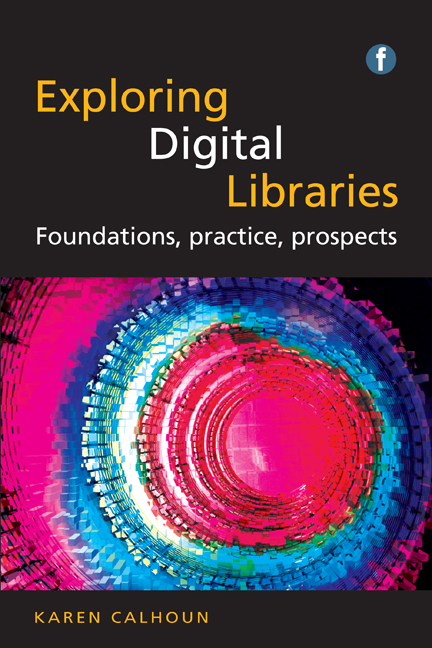Book contents
- Frontmatter
- Dedication
- Contents
- List of figures and tables
- Preface
- Acknowledgements
- Glossary
- 1 Emergence and definitions of digital libraries
- 2 Outcomes of digital libraries’ first decade
- 3 Key themes and challenges in digital libraries
- 4 Digital library collections: repositories
- 5 Hybrid libraries
- 6 Social roles of digital libraries
- 7 Digital libraries and their communities
- 8 The prospects of open access repositories
- 9 Digital libraries and the social web: scholarship
- 10 Digital libraries and the social web: collections and platforms
- References
- Index
9 - Digital libraries and the social web: scholarship
Published online by Cambridge University Press: 08 June 2018
- Frontmatter
- Dedication
- Contents
- List of figures and tables
- Preface
- Acknowledgements
- Glossary
- 1 Emergence and definitions of digital libraries
- 2 Outcomes of digital libraries’ first decade
- 3 Key themes and challenges in digital libraries
- 4 Digital library collections: repositories
- 5 Hybrid libraries
- 6 Social roles of digital libraries
- 7 Digital libraries and their communities
- 8 The prospects of open access repositories
- 9 Digital libraries and the social web: scholarship
- 10 Digital libraries and the social web: collections and platforms
- References
- Index
Summary
Overview
This chapter is the first of two that consider the responses of digital libraries to the social web and to web-based practices for information seeking, learning, teaching, research, professional recognition, work, recreation and socializing. Both chapters elaborate on ideas introduced in Chapters 3–8. This chapter's first part examines the origins and chaotic, fast-moving nature of the social web, explores the possibility of digital libraries as social platforms and introduces a visual framework that attempts to bring some coherence to the many confusing elements of digital libraries’ evolution toward the social web. The second part of the chapter turns to the branches of the visual framework that pertain to the social web's existing, emergent, or potential impacts on scholarship, research and researchers.
Introduction
As discussed in Chapter 6, the public library framework developed by McClure (1987) casts library roles in terms of direct involvement in the communities to be served. Their framework is liberating in that it shifts attention away from an information-processing or collection-centric definition of libraries toward a community-centric definition. In the same way, the advent of the social web provides an opportunity to shift the focus and core assumptions of digital libraries away from their collections and information processes (selecting, organizing, providing access, etc.) in favor of new ways of thinking about services, expectations and potential social roles. Before considering specific opportunities afforded by the social web, it is necessary to spend some time considering its background.
background: Web 2.0 and library 2.0
Tim O'Reilly dates the first use of the phrase ‘Web 2.0’ to a conversation he had with Dale Dougherty at a 2004 technology conference (O'Reilly, 2005). They intended the phrase to mark not just a turning point for the web following the dot-com collapse of 2001, but also to capture new notions of the web as a platform for participation, characterized by:
• machine-to-machine interactions (syndication, web services and mashups)
• significant user interface innovation
• a bias for two-way ‘conversation’ rather than one-way information dissemination
• radically democratized and collaborative content creation and exchange
• open, re-usable data.
Information
- Type
- Chapter
- Information
- Exploring Digital LibrariesFoundations, Practice, Prospects, pp. 209 - 236Publisher: FacetPrint publication year: 2014
